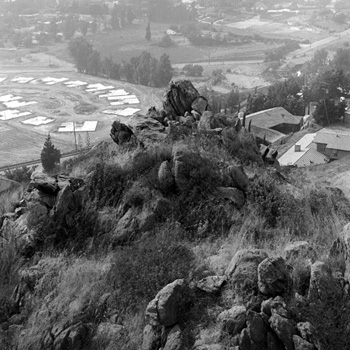
Continuing through December 31, 2011
The full title of this exhibition, “Seismic Shift: Lewis Baltz, Joe Deal and California Landscape Photography, 1944-1984,” telegraphs the thesis borne out by three catalog essays and the evidence supplied by 143 photographs by 43 photographers (including Ansel Adams, Weston père et fils, Minor White, Robert Adams, John Divola, Wynn Bullock, Catherine Wagner, Laurie Brown, William A. Garnett and others in addition to Baltz and Deal).
It is the story of a break, at once geographical and paradigmatic, between two generations of California photographers. The older generation, based in Northern California and counting Ansel Adams and Edward Weston as its luminaries, had envisioned nature in terms deriving from a Romantic conception of nature as the embodiment of pristine authenticity that contrasted with the grubby shabbiness of the man-made world and the corrupting social rituals necessitated by commerce. In the wildernesses he photographed, Adams found intimations of the eternal. By contrast, in LA’s urban sprawl, he saw only a “hell we are building here on earth.” Weston, for his part, shunned almost all social contact, preferring instead the solitude of Point Lobos. For Minor White, who revered Weston, the photography of nature and, specifically, the ocean, was a means toward finding visible form for internal states.
The younger artists did not so much go seeking for an alternative vision as were forced into it by their encounter with a landscape increasingly disrupted by suburban and industrial developments so vast as to rival the geologic events that had originally formed it. Recollecting his experience of this postwar California setting, Baltz would remark, “I was living in Monterey, a place where the classic photographers — the Westons, Wynn Bullock and Ansel Adams — came for a privileged view of nature. But my daily life very rarely took me to Point Lobos or Yosemite; it took me to shopping centers, and gas stations and all the other unhealthy growth that flourished beside the highway. It was a landscape that no one else had much interest in looking at. Other than me.”
In the late sixties, Baltz, while enrolled in the MA program at Claremont College, began photographing tract houses. By 1971, John Divola was cataloging San Fernando Valley homes and their owners. As Susan Laxton notes in one of the exhibition’s catalog essays, the shift in photographic interest from sublime to degraded (or manufactured) nature coincided with the Land Art movement and the dysphoric or deadpan documentation of urban sites and their infrastructure produced by Robert Smithson, Dan Graham, and Ed Ruscha.
Initially, however, the California photographers who in 1975 would be included in the group-defining exhibition “New Topographics: Photographs of a Man-Altered Landscape” at George Eastman House in Rochester, New York (where Deal met Baltz while the former was working there as a security guard) tended to think of their subject matter as architecture not landscape. This is perhaps indicative of the attachment to the transcendental that the notion of landscape still retained at that point, thanks to the prestige of the older generation of photographers together with a resistance against admitting into the landscape category the desublimated hybrid space of real estate.
The insight that finally forced his hand came to Deal while he was at the University of New Mexico working on his MA during the 1973-74 academic year. Asked to contribute an image for a poster, he went looking for a rock in the desert, climbed a hillside overlooking Albuquerque, and had his epiphany: “… and it just startled me that here, spread before me, was what I’d been looking for in photographing suburbia: that it wasn’t just one house, and my interest wasn’t in architecture — that I had been going the wrong direction with it, trying to photograph the buildings. I wanted to photograph the landscape, and the buildings became part of the landscape.”
To their depiction of this processed landscape, Deal and Baltz brought a radical, horizonless flatness that as exhibition organizer Colin Westerbeck notes made “the vast open, spaces of the Western landscape in earlier photography alarmingly claustrophobic. Their photography documented, truly, the closing of the frontier.”
Deal would later demurely state that he had had no intention of upending the hallowed legacy of the earlier landscapists. Baltz, on the other hand, would push his forensic examination of non-sustainable land use to the point where the absenting of the transcendent generates something like a sublime void. In light of this, the question posed by Jason Weems in his catalog essay — “Is it not likely that these photographers’ goals in focusing on the everyday were not strident critique, but instead the development of an understanding, necessarily incomplete, of its possibilities?” — seems misplaced. The possibilities of the everyday disclosed in the work of the New Topographics seem to be entirely aesthetic possibilities that are un-affirmative of their referent. The everyday in the photographs of Deal, Baltz, Frank Gohlke, and John Schott is as notable for what it does not contain as for what it does. The general impression is of a construction site in perpetual flux, where the instantaneity with which houses, offices, and malls appear suggests both the ephemerality of these structures and that of whatever social and familial connection they support.
Robert Adams got closer to the truth of the New Topographics when he noted why it was no longer possible to approach landscape as Ansel Adams had done: “Scenic grandeur is today sometimes painful. The beautiful places to which we journey for inspiration surprise us by the melancholy they can induce ... Unspoiled places sadden us because they are, in an important sense, no longer true.”
It was less a question of uncovering new possibilities as it was of letting go of possibilities that no longer existed.
